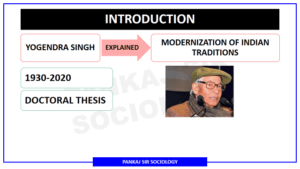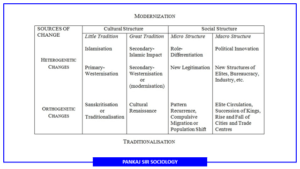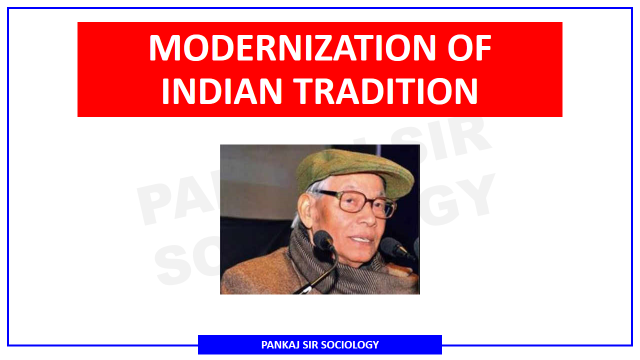BACKGROUND
After the Second World War, many countries in Africa, Asia, and Latin America struggled to progress economically despite being exposed to capitalism. Western nations, particularly the United States, worried about the potential spread of communism in these regions, which could threaten American business interests and influence. To counter this, modernization theory emerged in the late 1940s, advocating for a non-communist approach to addressing poverty in developing countries. The theory promoted industrialized capitalism and the adoption of Western democratic ideals as a solution for development.
THEORIES OF MODERNIZATION
- Modernization theory delves into the evolution of societies and the process of social development. It comprises two main levels of analysis: microcosmic assessments, which focus on the individual components of social modernization, and macrocosmic studies, which examine the empirical paths and visible processes of modernization within nations encompassing their societies, economies, and governance structures.
- The progression of modernization began post-World War II, marked by significant events such as the rise of the United States as a global superpower, aiming to counter the spread of communism. To achieve this containment objective, the U.S. heavily invested in bolstering the economic foundations of specific countries like Western Europe, South Korea, and Japan.
- Modernization was also influenced by the growth of communist movements in countries such as China, Vietnam, the former Soviet Union (no longer a communist bloc), and Cuba. Another key aspect was the decolonization processes in Asia and Africa, leading to the independence of colonies under European control.
- Following decolonization, newly independent nations faced the challenge of adopting suitable growth models. The U.S. supported these countries by dispatching large teams of social scientists to assess their circumstances. This effort aimed to explore how capitalist ideologies could drive economic progress in these nations, many of which had endured impoverishment during prolonged colonization marked by resource depletion and exploitation. The exploitation involved exporting raw materials, transforming them into goods for re-export, generating significant economic gains.
- This strategic shift towards capitalism was not only a response to the influence of communist ideologies but also aimed to counter and diminish their impact gradually. Political tactics and ideological considerations played a crucial role in the modernization process.
- Scholars across various social science disciplines conducted in-depth studies on these societies, with their findings emerging shortly after World War II. The primary analytical tools employed and subsequently published included evolutionary theory and functionalist theory.
MODERNIZATION: YOGENDRA SINGH

- Yogendra Singh begins by noting that before Modernization, Indian traditions were based on principles of hierarchy, holism, continuity, and transcendence. These traditions were somewhat similar to those of the traditional West, but ultimately diverged due to unique historical backgrounds, social and cultural heritages, and overall social contexts. Singh questions whether these differences would prevent the development of a universal model of Modernization.
- He explains that social change does not necessarily equate to Modernization, as pre-modern changes were either internally driven (ortho-genetic) or externally imposed (hetero-genetic).
- For example, the Islamic tradition in India was heterogenetic, established through conquest, and while Hinduism underwent endogenous changes through Sankritisation, which was a long-term historical process focused on social positioning rather than structural transformation.
- Modernization in India began with contact with the West, leading to significant changes in social structure, but not all interactions resulted in Modernization.
- During the British colonial period, Modernization in India was selective and gradual, not aligned with traditional structures like family, caste, and village.
- The British administration prioritized other aspects over these traditional structures, particularly after the 1857 revolt. They viewed family, caste, and village systems as static and independent, especially the caste system and village autonomy. Caste played a role in the military, bureaucracy, and the introduction of communal electorates in the national movement.
- Yogendra Singh believes these factors influenced the post-colonial Modernization process. Modernization in India gained momentum during the freedom struggle led by Mahatma Gandhi, whose actions and mobilization of the masses created a new political culture of Modernization, according to Singh.

CRITIQUE OF MODERNIZATION THEORY
- No nations have adhered strictly to the Modernization Theory’s principles, such as Rostow’s “5 stages of growth.” This theory, formulated long ago, was partly designed to validate the dominance of Western capitalist nations, many of which were colonial powers, while undermining Communism. Consequently, the theory is considered weak due to its historical biases and lack of real-world examples of successful implementation.
- The Modernization Theory suggests that Western civilization is seen as both technically and morally superior to traditional societies. It implies that the values of developing nations hold less significance compared to those of the West.
- However, many developed countries also face significant inequalities, with higher levels of inequality often leading to a range of issues such as increased crime rates, suicide rates, and health problems like cancer and drug abuse.
Task question – Examine Yogendra Singh’s theory on the Modernization of Indian Tradition and assess its relevance in today’s context. (20 Marks)
Answer writing pattern–
Structure: Introduction/Background:
Overview of Singh’s modernization theory:
Application to current global and local contexts:
Critique:
Conclusion:



